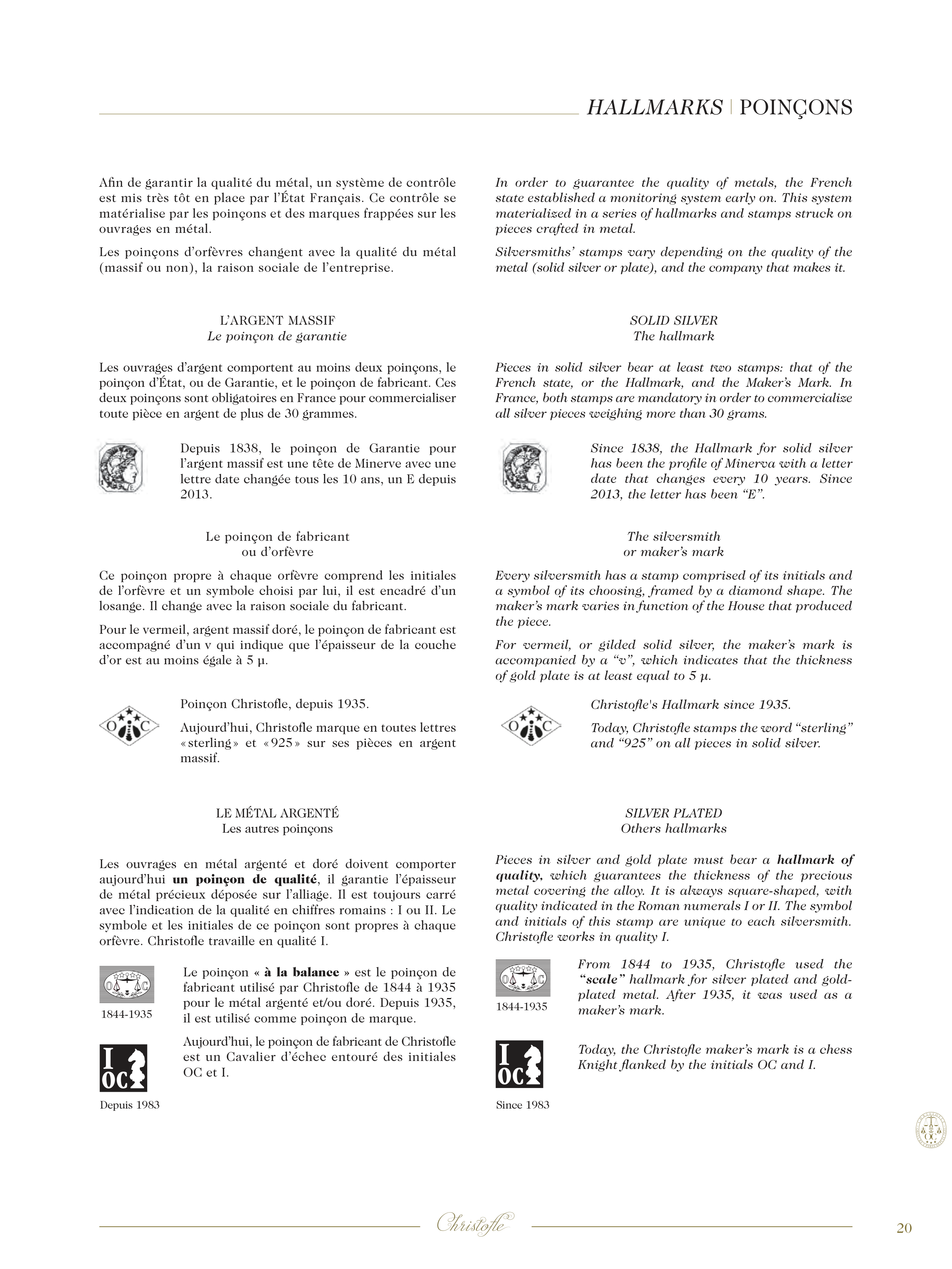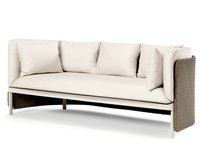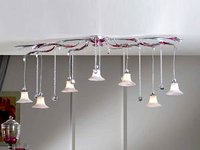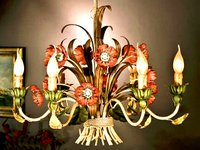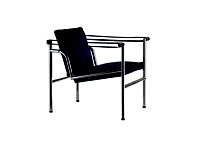20
Afin de garantir la qualité du métal, un système de contrôle
est mis très tôt en place par l’État Français. Ce contrôle se
matérialise par les poinçons et des marques frappées sur les
ouvrages en métal.
Les poinçons d’orfèvres changent avec la qualité du métal
(massif ou non), la raison sociale de l’entreprise.
In order to guarantee the quality of metals, the French
state established a monitoring system early on. This system
materialized in a series of hallmarks and stamps struck on
pieces crafted in metal.
Silversmiths’ stamps vary depending on the quality of the
metal (solid silver or plate), and the company that makes it.
L’ARGENT MASSIF
Le poinçon de garantie
Les ouvrages d’argent comportent au moins deux poinçons, le
poinçon d’État, ou de Garantie, et le poinçon de fabricant. Ces
deux poinçons sont obligatoires en France pour commercialiser
toute pièce en argent de plus de 30 grammes.
SOLID SILVER
The hallmark
Pieces in solid silver bear at least two stamps: that of the
French state, or the Hallmark, and the Maker’s Mark. In
France, both stamps are mandatory in order to commercialize
all silver pieces weighing more than 30 grams.
Le poinçon de fabricant
ou d’orfèvre
Ce poinçon propre à chaque orfèvre comprend les initiales
de l’orfèvre et un symbole choisi par lui, il est encadré d’un
losange. Il change avec la raison sociale du fabricant.
Pour le vermeil, argent massif doré, le poinçon de fabricant est
accompagné d’un v qui indique que l’épaisseur de la couche
d’or est au moins égale à 5 µ.
The silversmith
or maker’s mark
Every silversmith has a stamp comprised of its initials and
a symbol of its choosing, framed by a diamond shape. The
maker’s mark varies in function of the House that produced
the piece.
For vermeil, or gilded solid silver, the maker’s mark is
accompanied by a “v”, which indicates that the thickness
of gold plate is at least equal to 5 µ.
LE MÉTAL ARGENTÉ
Les autres poinçons
Les ouvrages en métal argenté et doré doivent comporter
aujourd’hui un poinçon de qualité, il garantie l’épaisseur
de métal précieux déposée sur l’alliage. Il est toujours carré
avec l’indication de la qualité en chiffres romains : I ou II. Le
symbole et les initiales de ce poinçon sont propres à chaque
orfèvre. Christofle travaille en qualité I.
Le poinçon « à la balance » est le poinçon de
fabricant utilisé par Christofle de 1844 à 1935
pour le métal argenté et/ou doré. Depuis 1935,
il est utilisé comme poinçon de marque.
Aujourd’hui, le poinçon de fabricant de Christofle
est un Cavalier d’échec entouré des initiales
OC et I.
SILVER PLATED
Others hallmarks
Pieces in silver and gold plate must bear a hallmark of
quality, which guarantees the thickness of the precious
metal covering the alloy. It is always square-shaped, with
quality indicated in the Roman numerals I or II. The symbol
and initials of this stamp are unique to each silversmith.
Christofle works in quality I.
From 1844 to 1935, Christofle used the
“scale” hallmark for silver plated and gold-
plated metal. After 1935, it was used as a
maker’s mark.
Today, the Christofle maker’s mark is a chess
Knight flanked by the initials OC and I.
Depuis 1838, le poinçon de Garantie pour
l’argent massif est une tête de Minerve avec une
lettre date changée tous les 10 ans, un E depuis
2013.
Since 1838, the Hallmark for solid silver
has been the profile of Minerva with a letter
date that changes every 10 years. Since
2013, the letter has been “E”.
Poinçon Christofle, depuis 1935.
Aujourd’hui, Christofle marque en toutes lettres
«sterling» et «925» sur ses pièces en argent
massif.
Christofle's Hallmark since 1935.
Today, Christofle stamps the word “sterling”
and “925” on all pieces in solid silver.
HALLMARKS POINÇONS
1844-1935
1844-1935
Depuis 1983
Since 1983


